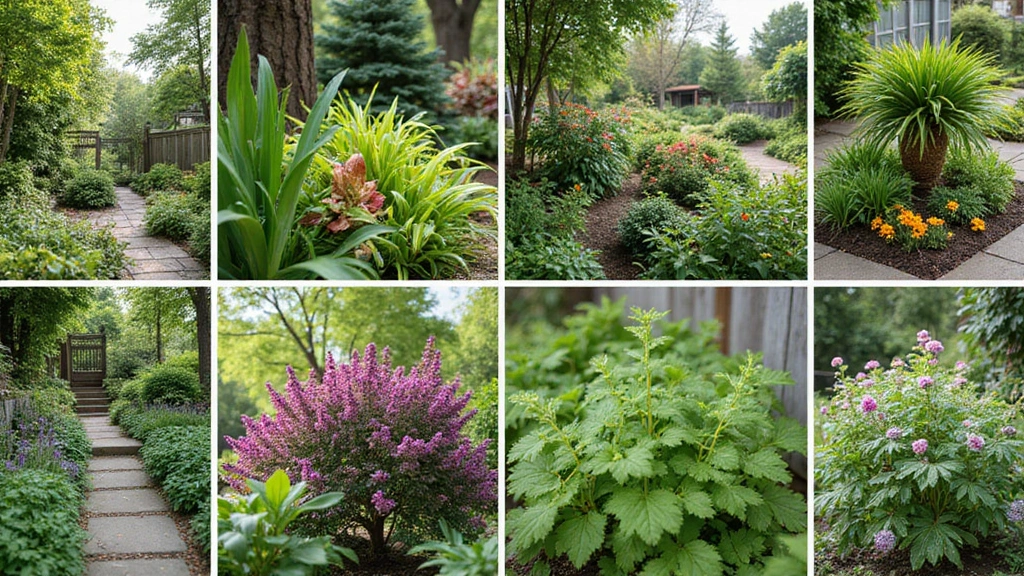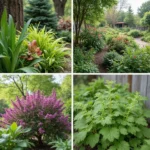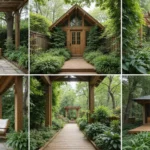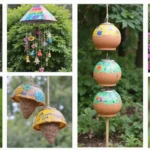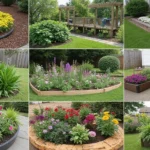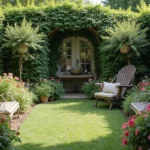Sprucing up your garden can do wonders, especially in small spaces. With a bit of creativity and sustainable practices, you can achieve a stunning landscape without breaking the bank.
This collection features 30 unique garden landscaping ideas that not only enhance aesthetics but also promote sustainability. From vertical gardens to native plant selections, these concepts will inspire you to turn your yard into a lush retreat. Perfect for both front yard makeovers and backyard landscaping tips, these ideas align with the latest garden design trends and outdoor living spaces.
Get ready to dig into these transformative ideas that cater to small areas while ensuring our planet stays green!
1. Vertical Gardens: A Space-Saving Marvel
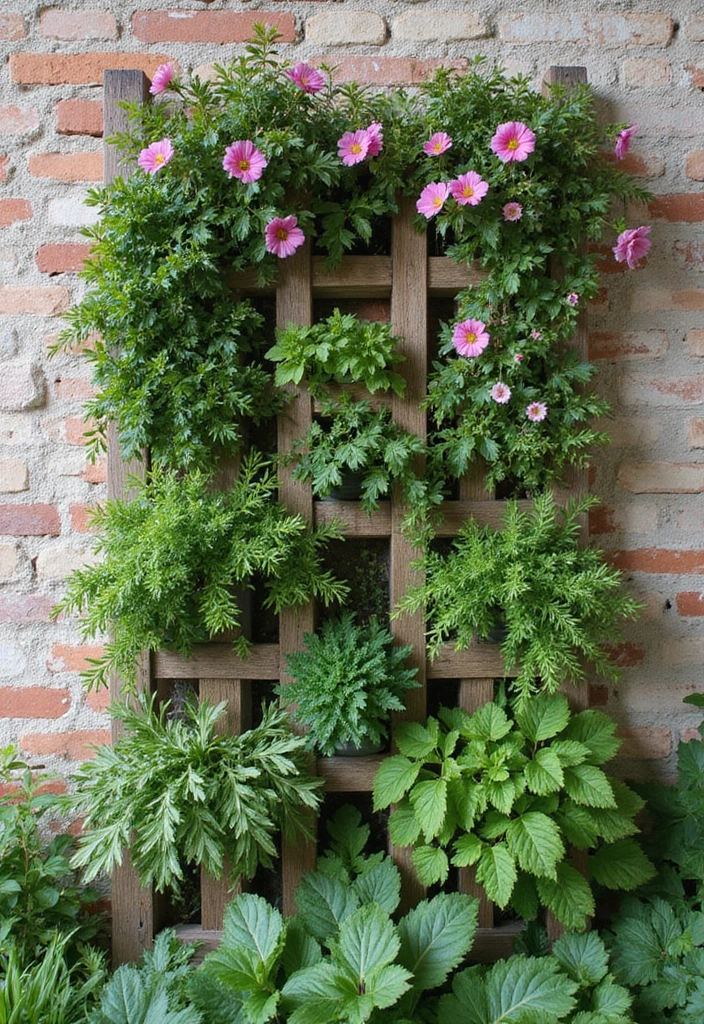
Vertical gardens are an ideal solution for those with limited yard space. They allow you to grow beautiful plants upward instead of outward, making the most of your square footage.
Start by selecting a sturdy trellis or wall-mounted planters, and choose plants that thrive in vertical settings, like climbing vines or hanging succulents. Consider mixing herbs and flowers for a delightful visual and aromatic experience.
These gardens can also reduce heat around your home and help mitigate noise pollution. Plus, they create a stunning focal point, perfect for outdoor entertaining!
– Choose plants according to sunlight availability.
– Use organic potting mixes to promote healthy growth.
– Consider drip irrigation to keep care minimal!
Embrace vertical gardening to elevate your green space!
2. Raised Garden Beds: Practical and Stylish
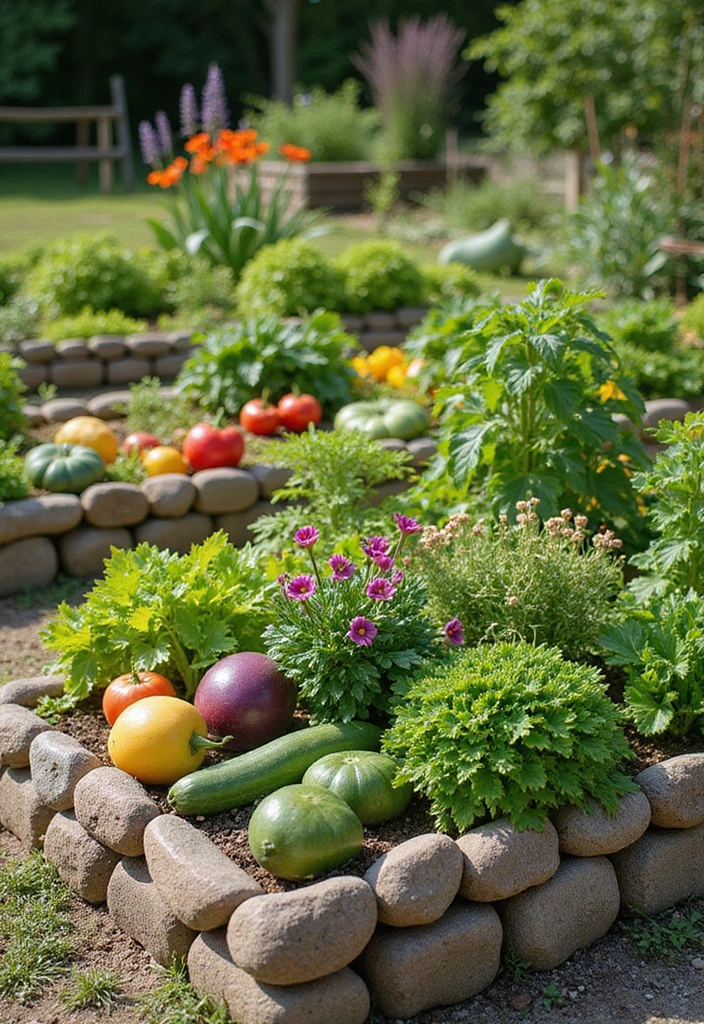
Raised garden beds are perfect for ensuring optimal drainage and soil quality while adding a structured element to your yard. They also make gardening more accessible!
Construct your beds with reclaimed wood or natural stone to add rustic charm. Fill them with nutrient-rich soil and plant your favorite vegetables or flowers. Raised beds offer better control over soil conditions and can even reduce weeds.
Benefits include:
– Easier maintenance and watering.
– Better pest control with a slight elevation.
– A defined boundary that enhances your yard’s overall design.
Adding a few decorative stones around the edges can give your garden a polished look. Your small space can become a vibrant food source with raised beds!
3. Native Plants: The Best for Sustainability
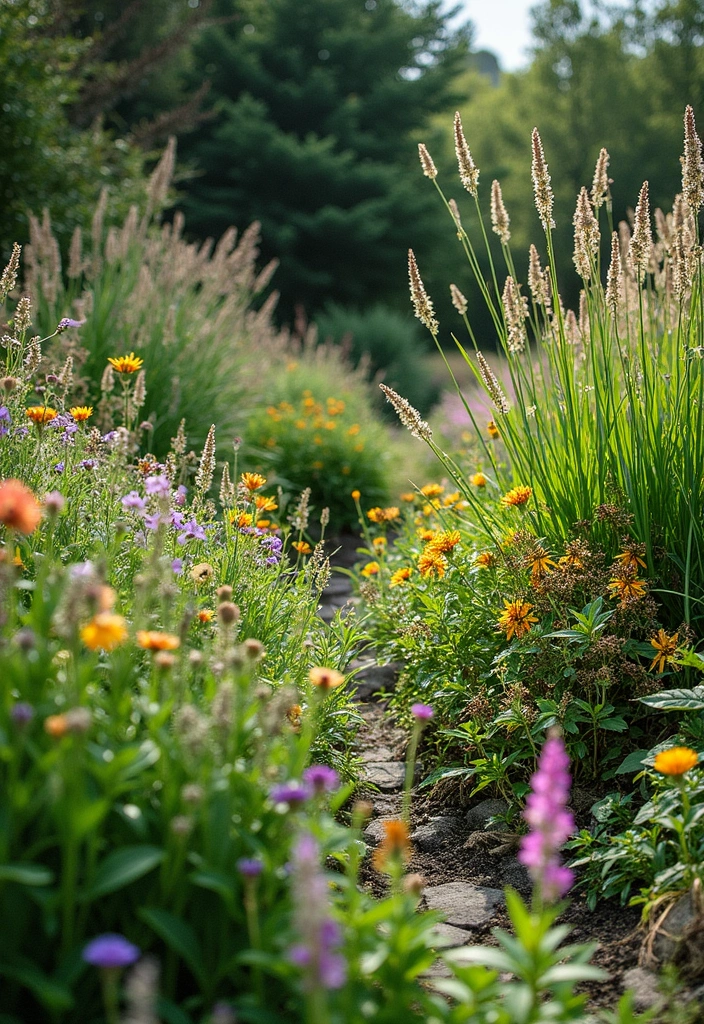
Utilizing native plants in your landscaping is a fantastic way to support local ecosystems and minimize water usage. These plants require less maintenance and are adapted to your local climate.
Research your region’s native species, and consider creating a wildflower garden or a native plant selection.
Advantages:
– Attracts beneficial insects like pollinators.
– Requires fewer resources, leading to lower water bills.
– Maintains local biodiversity and supports wildlife.
Mix in some native grasses and shrubs for layered textures. In a small yard, a native garden can create an enchanting, natural retreat that’s both beautiful and eco-friendly!
4. Xeriscaping: Water-Wise Landscaping
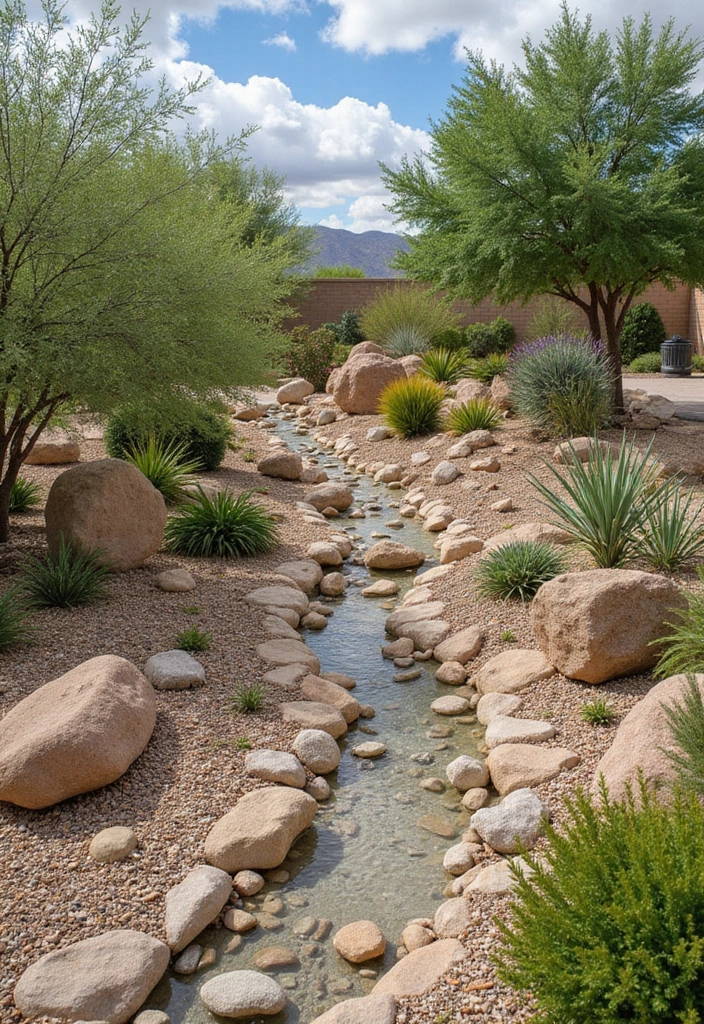
Xeriscaping is a landscaping technique that conserves water by using drought-resistant plants and efficient irrigation methods. This approach transforms dry areas into beautiful, sustainable landscapes.
Incorporate rocks, gravel, and native plants to create a low-water garden that still looks fabulous. Succulents, cacti, and ornamental grasses are excellent options that thrived in arid conditions.
Helpful tips:
– Group plants with similar water needs together.
– Install a drip irrigation system for efficiency.
– Add mulch to retain moisture in the soil.
With xeriscaping, your garden can thrive even in the driest conditions, saving you time and water while keeping your yard stunning.
5. Edible Landscaping: Combining Beauty and Function
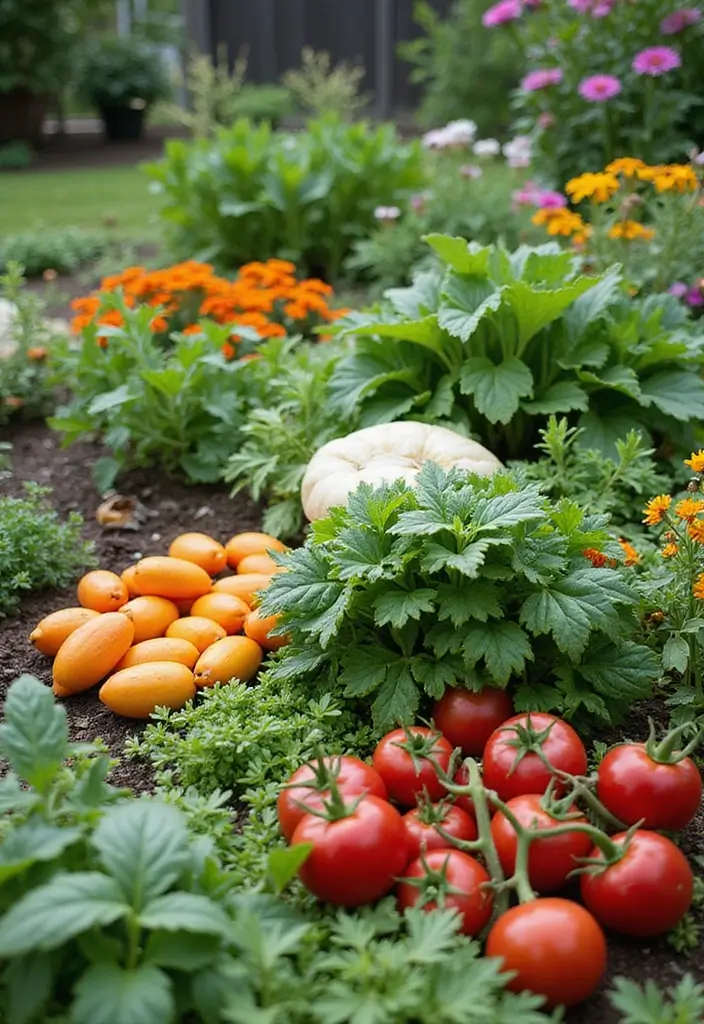
Why not have a garden that looks good and feeds you? Edible landscaping integrates food plants with ornamental plants, creating a beautiful yet functional outdoor space.
Plant herbs like rosemary or basil among your flowers. Incorporate fruit trees or berry bushes that not only serve culinary purposes but add seasonal beauty. Think about color and texture when choosing plants to ensure your garden remains visually appealing throughout the year.
Considerations:
– Use companion planting to manage pests naturally.
– Incorporate colorful vegetables for a vibrant display.
– Choose organic seeds and plants to promote sustainability.
Edible landscapes are an innovative way to enjoy nature and nutrition right from your yard!
6. Pathways and Walkways: Create a Journey
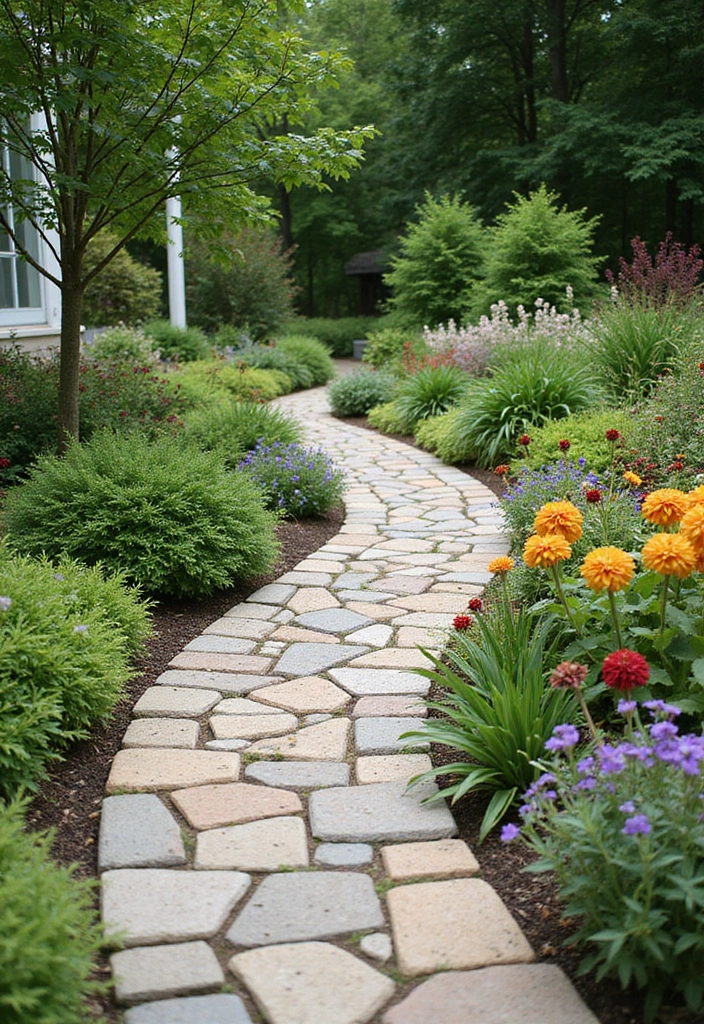
Pathways can dramatically increase the attractiveness of your garden while providing functional routes through your space. They guide visitors and separate different areas of your garden.
Consider materials like flagstone, gravel, or recycled bricks for a rustic feel. Add plants along the edges to create a natural boundary and soften the look. Pathways also add depth and dimension to your yard, drawing the eye.
Pro tips:
– Use curves instead of straight lines for a more organic feel.
– Surround paths with low-growing plants to keep the focus on the walkway.
– Incorporate lighting for nighttime appeal.
Transform your small yard into a wanderer’s paradise with thoughtful pathways that encourage exploration and engagement with nature.
7. Containers and Pots: Versatile and Chic

Container gardening is perfect for small spaces, allowing you to grow plants in pots on patios, balconies, or even window sills. This method offers incredible versatility in plant selection and design.
Choose various pots in different shapes, colors, and sizes for an eclectic look. Use herbs, flowers, or small trees to create visual interest. Mixing and matching pots can add a fun and personalized touch to your outdoor space.
for success:
– Ensure proper drainage to keep plants healthy.
– Choose lightweight materials for easy movement.
– Group containers for greater impact and make watering easier.
Containers can be an instant garden solution, transforming bare spaces into vibrant displays of life!
8. Natural Privacy Screens: Organic Barriers
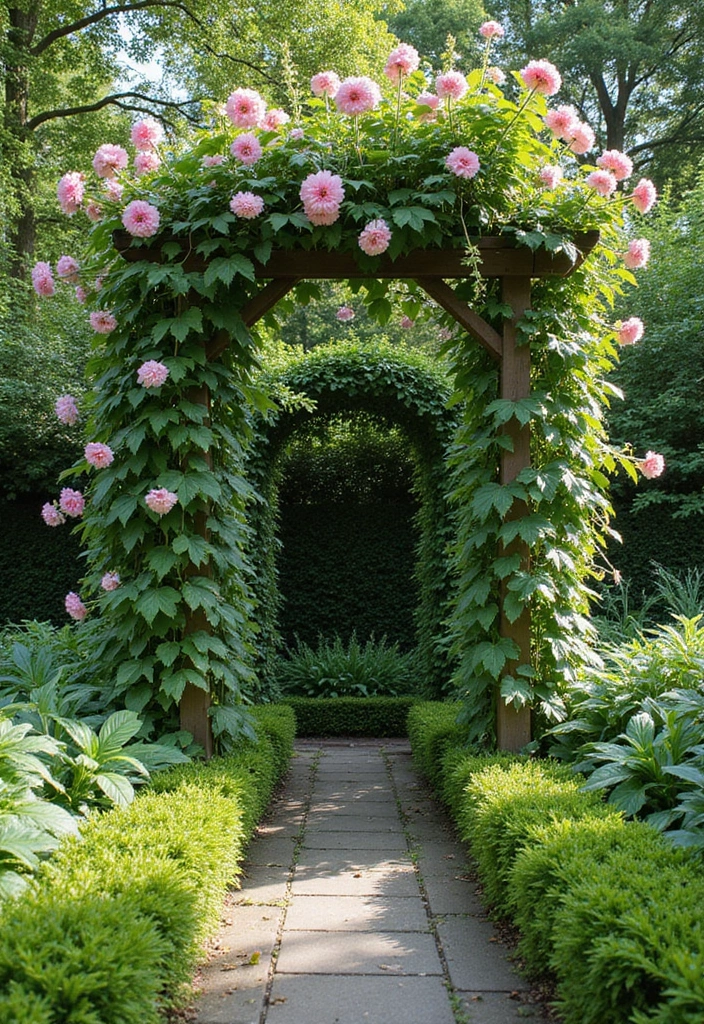
Creating privacy in your outdoor space can be as simple as planting tall shrubs or installing trellises with climbing plants. These natural barriers add beauty while providing the seclusion you desire.
Consider fast-growing varieties like bamboo or compact evergreens for quick results. Mixing textures can enhance visual appeal, with flowering vines wrapping around your trellis.
Things to keep in mind:
– Choose plants that suit your climate.
– Incorporate seasonal blooms for year-round interest.
– Plan for maintenance to keep your screens healthy and attractive.
Natural privacy screens enhance your outdoor living space while contributing to biodiversity and sustainability!
9. Garden Furniture: Comfort Meets Style

Creating outdoor living spaces requires the right furniture to make your garden feel like an extension of your home. Comfortable seating and tables can encourage you to spend more time enjoying nature.
Opt for eco-friendly materials like reclaimed wood or bamboo. Lightweight furniture can be easily rearranged to suit different occasions. Pair your furniture with cushions made from weather-resistant fabrics for comfort.
Considerations for a stylish layout:
– Create distinct zones for dining and lounging.
– Use rugs to define areas and add warmth.
– Incorporate shade solutions like umbrellas or pergolas.
Well-placed furniture can turn your garden into an inviting retreat, making it a perfect spot for relaxation or entertaining!
10. Sustainable Lawn Alternatives: Go Green

Traditional lawns can consume a lot of water and require constant mowing. Consider sustainable lawn alternatives like clover, native grasses, or ground cover plants that thrive in your area’s climate.
These alternatives often require less maintenance and water, making them an eco-friendly choice. They can also provide habitat for various insects and wildlife.
Benefits include:
– Lower maintenance costs and time.
– Enhanced beauty with diverse textures and colors.
– Support local ecology and biodiversity.
Transform your yard into a stunning and sustainable space that benefits the environment while providing a beautiful outdoor aesthetic!
11. Rain Gardens: Nature’s Water Filter
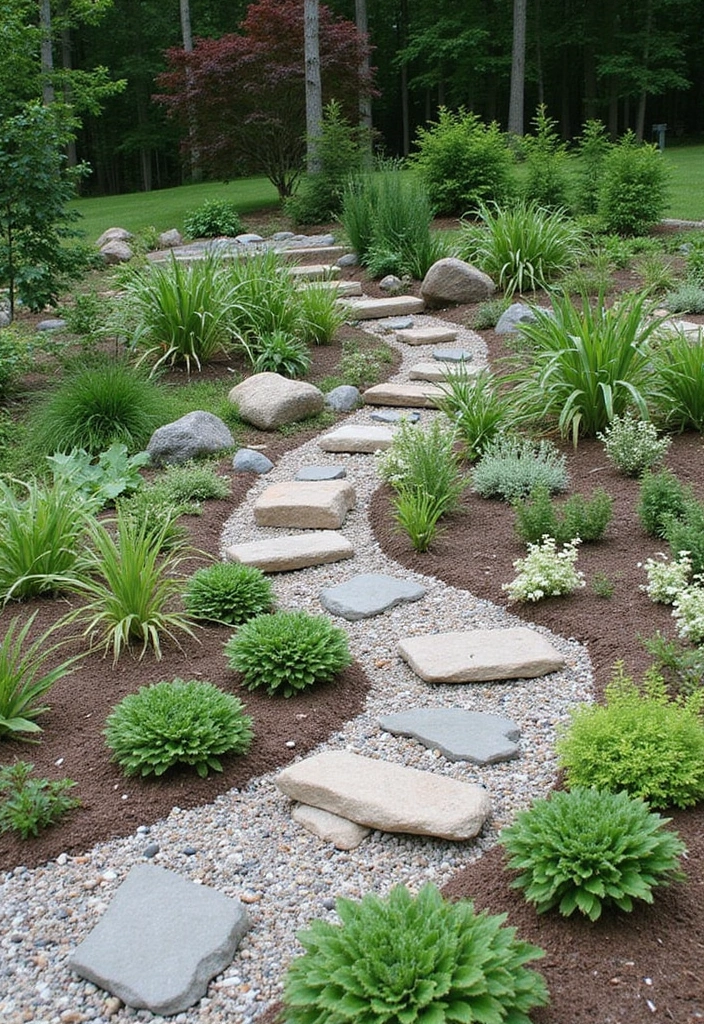
Rain gardens are a practical solution for managing stormwater runoff while adding beauty to your landscape. These specialized gardens use native plants to filter and absorb rainwater, reducing erosion and preventing flooding.
Position your rain garden in a low area of your yard to capture runoff from rooftops and driveways. Use plants that thrive in wet conditions, and consider integrating decorative stones for visual appeal.
for creating an effective rain garden:
– Plan for proper drainage to prevent standing water.
– Mix different plant heights for depth.
– Choose flowering plants for added color and interest.
Rain gardens are not only functional but can also be a standout feature in your landscaping!
12. Upcycled Decor: Eco-Chic Touches

Bringing upcycled decor into your garden is a creative way to express your personality while being environmentally friendly. Old furniture, wood, and other materials can be transformed into unique garden features or art.
For instance, turn an old ladder into a plant stand or use pallets to create seating or vertical gardens. This approach not only reduces waste but adds character to your outdoor space.
Considerations:
– Use non-toxic paints and finishes to ensure safety.
– Get creative with colorful designs or natural looks.
– Incorporate functional pieces like planters or trellises.
Upcycling allows you to add flair to your garden while aligning with sustainable practices!
13. Biophilic Design: Nature Indoors

Bringing elements of nature into your yard creates a calming atmosphere and promotes well-being. Biophilic design focuses on integrating natural forms, materials, and processes into your landscape.
Incorporate natural stone pathways, water features, and abundant plant life to mirror the beauty of untouched nature. Create cozy seating areas surrounded by lush greenery or colorful blooms.
Key ideas:
– Use natural materials like wood and stone.
– Add water features like ponds or fountains for tranquility.
– Create natural textures with a variety of plant heights and types.
Achieving biophilic design in your yard can enhance relaxation and create a peaceful outdoor haven.
14. Artistic Planters: Add a Pop of Creativity
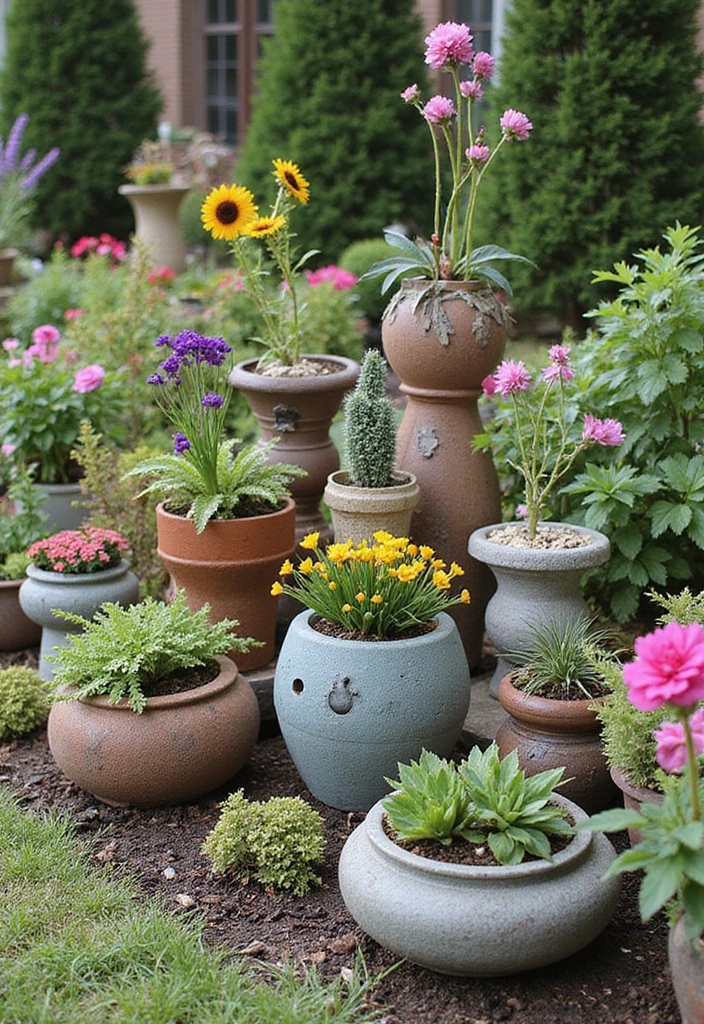
Artistic planters can serve as both functional gardening tools and stunning focal points in your landscape. Unique designs can elevate your plant displays and add character to your yard.
Look for planters made from unusual materials like concrete, metal, or ceramic, or try DIY projects to create your own. Group various sizes and shapes together for an eye-catching display.
Suggestions for enhancing your planters:
– Use vibrant flowers to contrast with the planter material.
– Incorporate height variations with raised or hanging planters.
– Add decorative touches such as fairy lights or moss.
Artistic planters can infuse your yard with personality and charm!
Elevate your garden with artistic planters! A splash of creativity can turn simple plants into stunning focal points that tell your unique story. Embrace the vibrant contrast of colors and materials for a truly transformed landscape!
15. Outdoor Lighting: Illuminate Your Garden
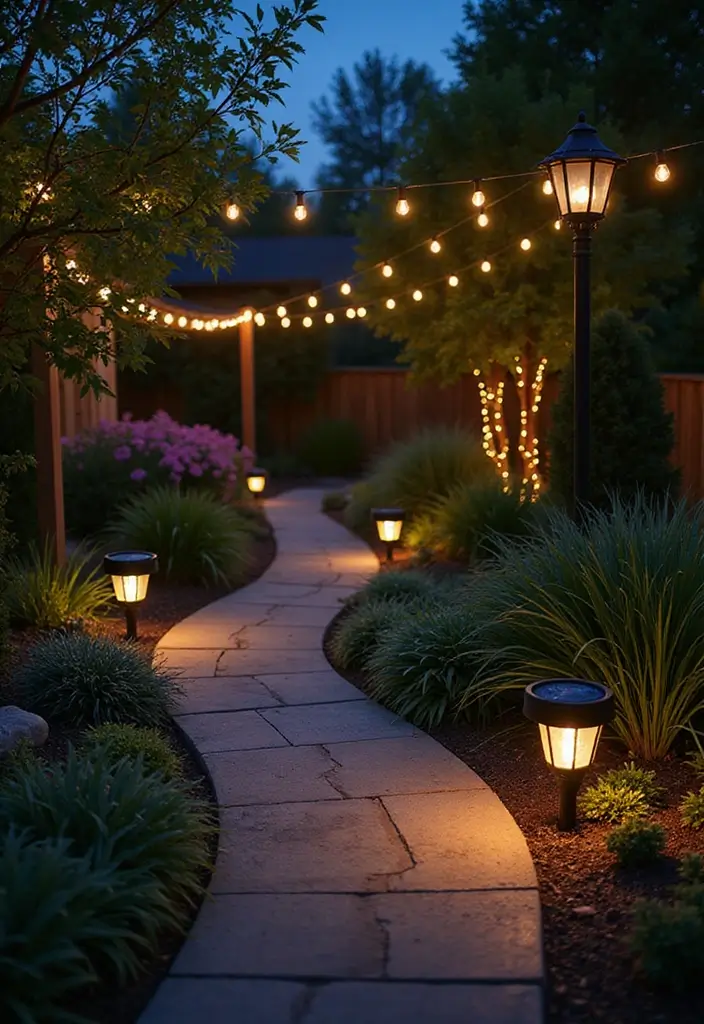
Proper lighting can dramatically change the ambiance of your garden space, making it inviting even after the sun goes down. Thoughtful outdoor lighting highlights features and creates a warm atmosphere.
Consider solar-powered lights along pathways, string lights over seating areas, or spotlights for focal points like trees or sculptures. Lighting can enhance safety while adding a magical touch to evening gatherings.
Ideas for effective outdoor lighting:
– Use soft, warm-toned bulbs for a cozy feel.
– Mix different types of lighting for versatility.
– Install timers or motion sensors for convenience.
Illuminating your garden not only enhances its beauty but also encourages enjoyment of outdoor spaces day and night!
16. Garden Arbors and Trellises: Architectural Beauty
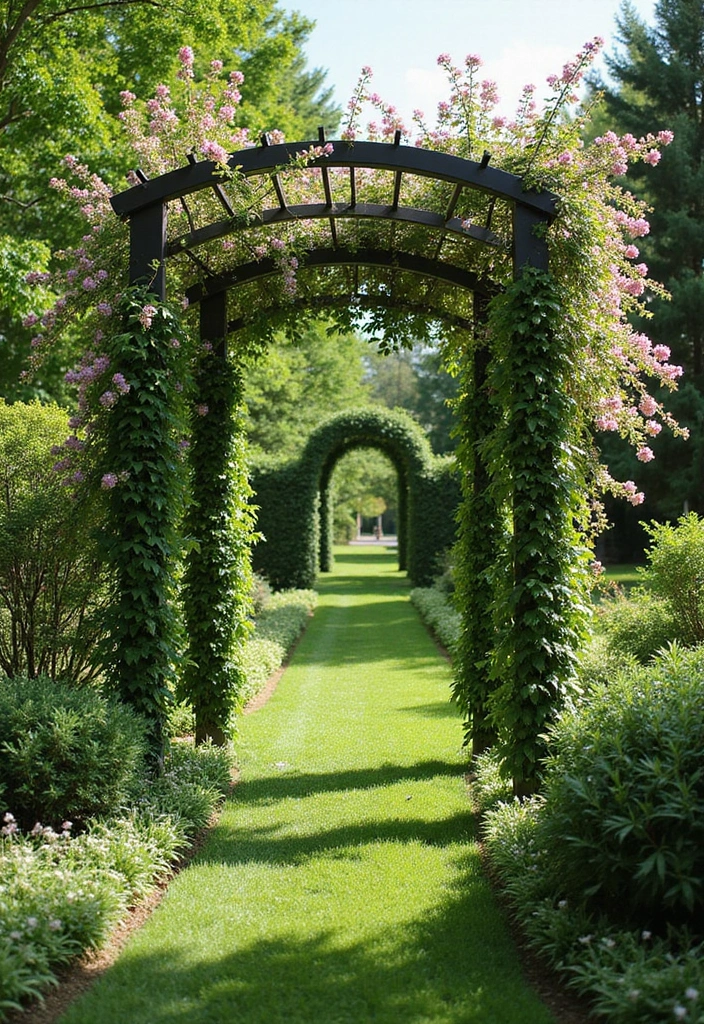
Arbors and trellises can add height and structure to any garden, creating a stunning architectural element. Use them to support climbing plants, creating shaded areas that invite relaxation.
These features can serve as natural gateways or transitions within your landscaping. Plant flowering vines, such as wisteria or clematis, to provide bursts of color and fragrance as they climb.
Considerations for your design:
– Choose materials that complement your home’s style.
– Plan for the plant growth and weight when installing.
– Consider positioning to maximize visual impact.
Incorporating arbors and trellises can elevate your landscape design while providing unique spaces to enjoy your garden’s beauty!
17. Colorful Foliage: Beyond Flowers
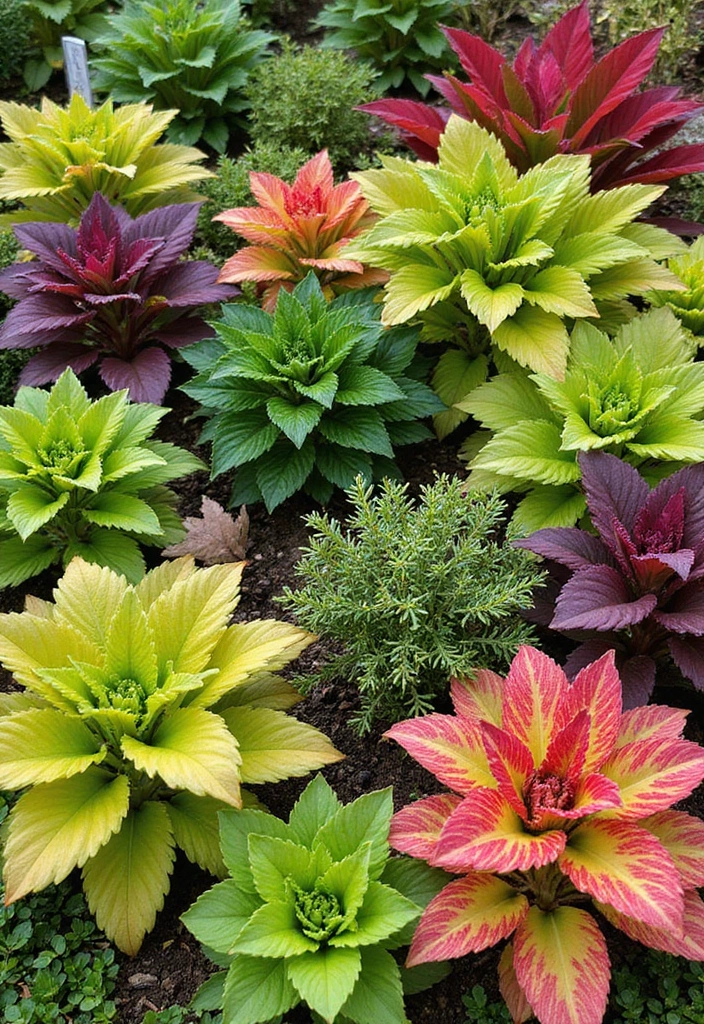
Incorporating colorful foliage can enhance your garden’s visual appeal beyond seasonal blooms. Plants with interesting leaves add texture and depth, making your yard engaging year-round.
Consider varieties like Japanese maples, colorful hostas, or ornamental cabbage that provide a visual feast of colors and shapes. Mixing different leaf colors and sizes can create striking contrast against blooming flowers.
Key points:
– Use foliage to create a layered look in your garden.
– Combine textures for a more dynamic appearance.
– Opt for plants with varying heights for depth.
By focusing on colorful foliage, you can ensure your garden remains vibrant and beautiful, regardless of the blooming season!
18. Water Features: Serenity in the Garden
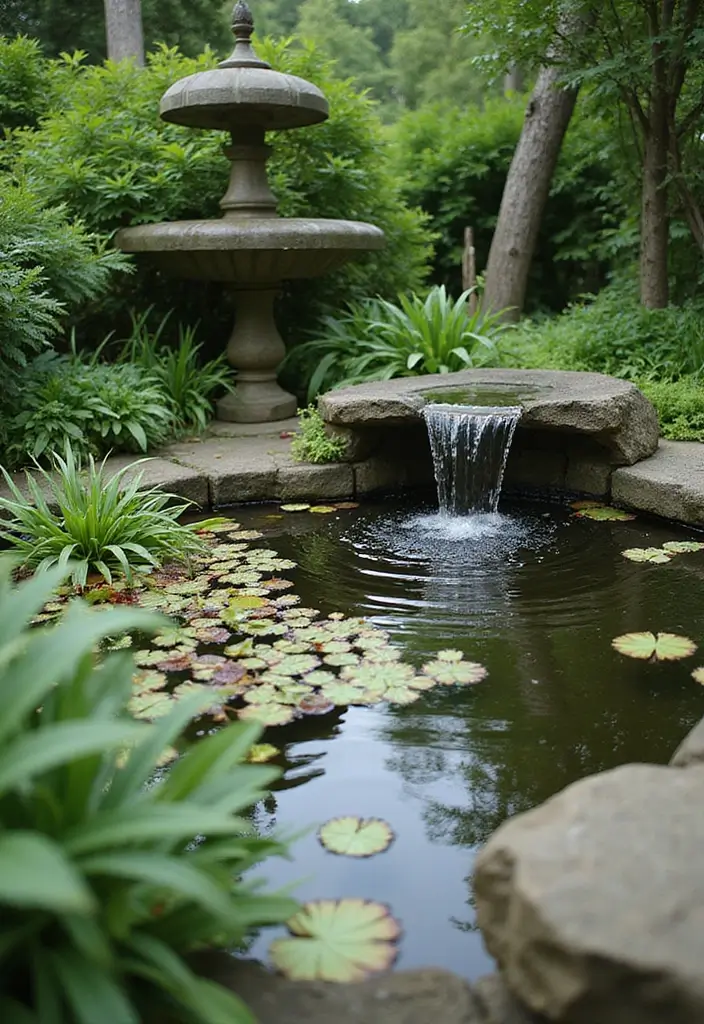
Incorporating water features such as ponds, fountains, or birdbaths can create a tranquil ambiance while attracting wildlife. The sound of running water adds relaxation to any outdoor space.
Ponds can support aquatic plants and fish, while fountains provide visual interest and soothing sounds. Small water features can be created even in limited spaces, such as tabletop fountains or birdbaths.
Considerations for water features:
– Choose a style that complements your overall landscaping.
– Plan for easy maintenance and water circulation.
– Incorporate surrounding plants to enhance the feature.
Water features can be a beautiful addition to your sustainable garden, enhancing both aesthetics and ecology!
19. Garden Art: Personal Touches

Adding elements of garden art can personalize your space and express your creativity. From sculptures to decorative stakes, these accents can become conversation starters.
Look for unique pieces that reflect your personality or create DIY art installations using materials you already have. Consider the colors and styles of your garden when choosing art to ensure it harmonizes with your plants.
for integrating art:
– Use large pieces to create focal points.
– Mix different art styles for an eclectic look.
– Place art at varying heights for visual interest.
Garden art enhances the charm of your outdoor space, making it uniquely yours!
20. Seasonal Interest: Year-Round Beauty
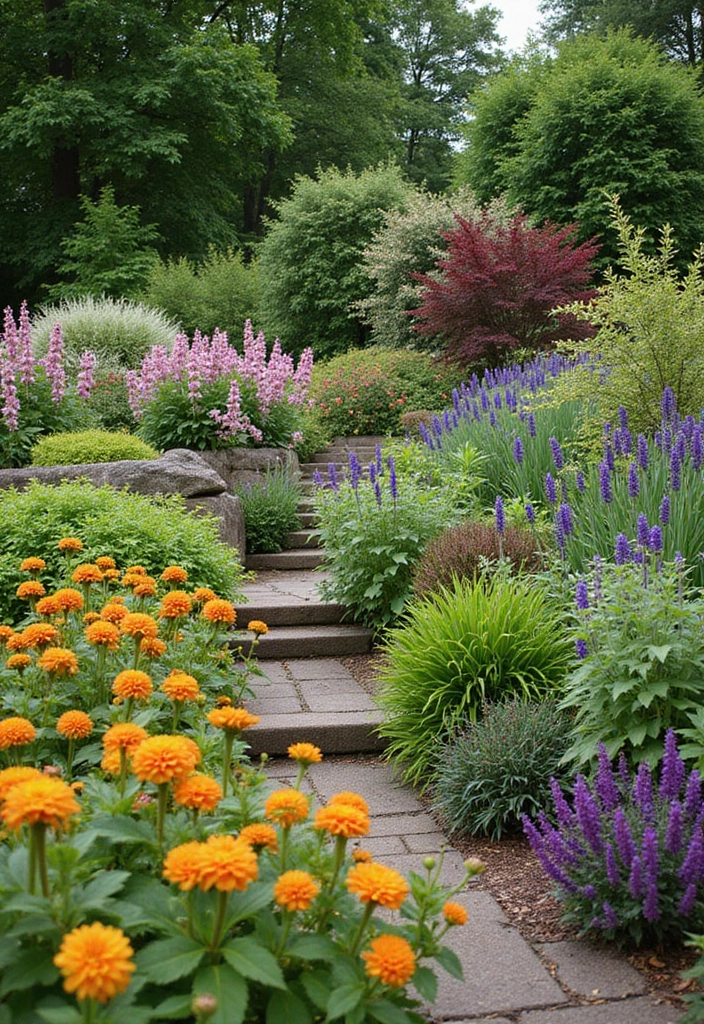
Creating a garden that looks good all year round requires planning for seasonal interest. Think about incorporating plants that bloom at different times or offer unique features during various seasons.
Select evergreens for winter appeal, spring bulbs for early blooms, and fall favorites like asters or chrysanthemums for late-season color. Group plants with varying bloom times for a continuous display.
Considerations:
– Research plants that thrive in your climate and seasonally available.
– Mix textures and heights to ensure year-round attractiveness.
– Plan for fall and winter visual interest as well.
With careful planning, your garden can be a stunning backdrop, no matter the season!
21. Community Gardens: Share the Love
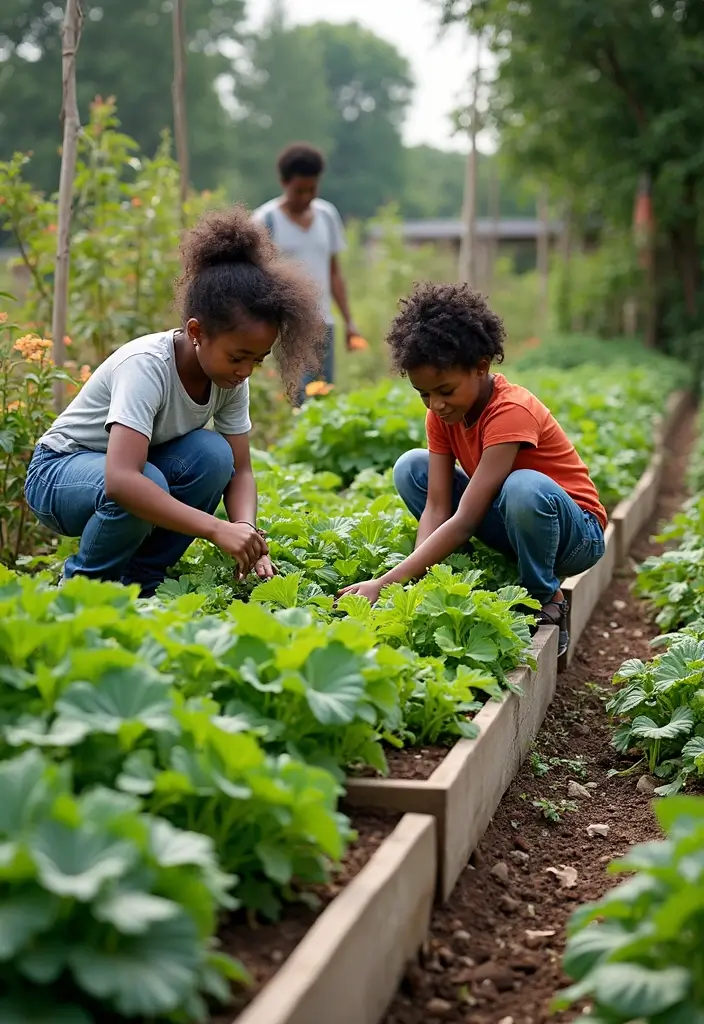
Engaging in community gardens can extend your gardening experience beyond your backyard. These shared spaces promote sustainability and community building, allowing you to enjoy fresh produce while meeting neighbors.
Participating in a community garden teaches valuable skills while fostering a sense of camaraderie. You can share resources, swap plants, and learn from other gardeners’ experiences.
Community garden benefits:
– Access to fresh, organic produce.
– Opportunity to learn about gardening and sustainability.
– Strengthens community bonds and friendships.
Join or start a community garden to share the joys of sustainable gardening with those around you!
In a community garden, every seed planted is a bond created. Share resources, swap plants, and cultivate friendships while enjoying fresh produce. Let’s grow together!
22. Composting: Enriching Soil Naturally
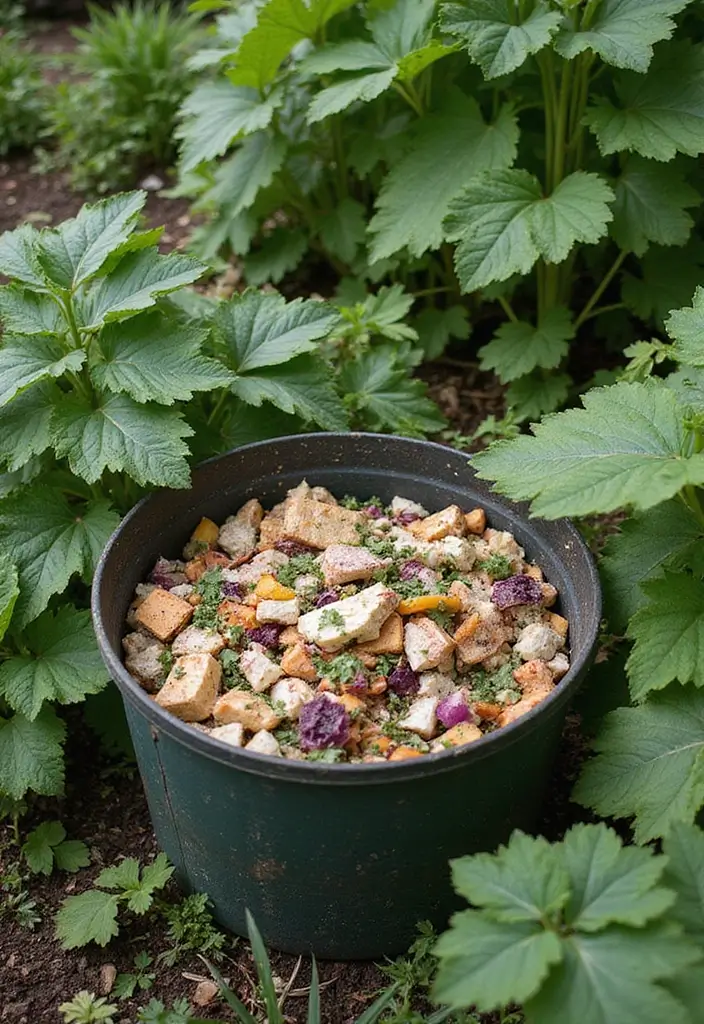
Composting is an excellent way to recycle kitchen scraps and yard waste while enriching your soil naturally. This sustainable practice reduces waste and creates a nutrient-rich amendment for your garden.
Set up a compost bin in a discreet corner of your yard. Add materials like vegetable peels, coffee grounds, and dry leaves to create a balanced mix. Turn the compost regularly to aerate it and speed up decomposition.
Benefits of composting include:
– Improved soil structure and moisture retention.
– Reduced need for chemical fertilizers.
– Decreased landfill contributions.
Composting not only supports your plants but also fosters a sustainable gardening practice that benefits the earth!
Turn kitchen scraps into garden gold! Composting enriches your soil naturally, giving your plants the nutrients they crave while reducing waste. It’s a win-win for your garden and the planet!
23. Aromatic Gardens: Scented Retreats
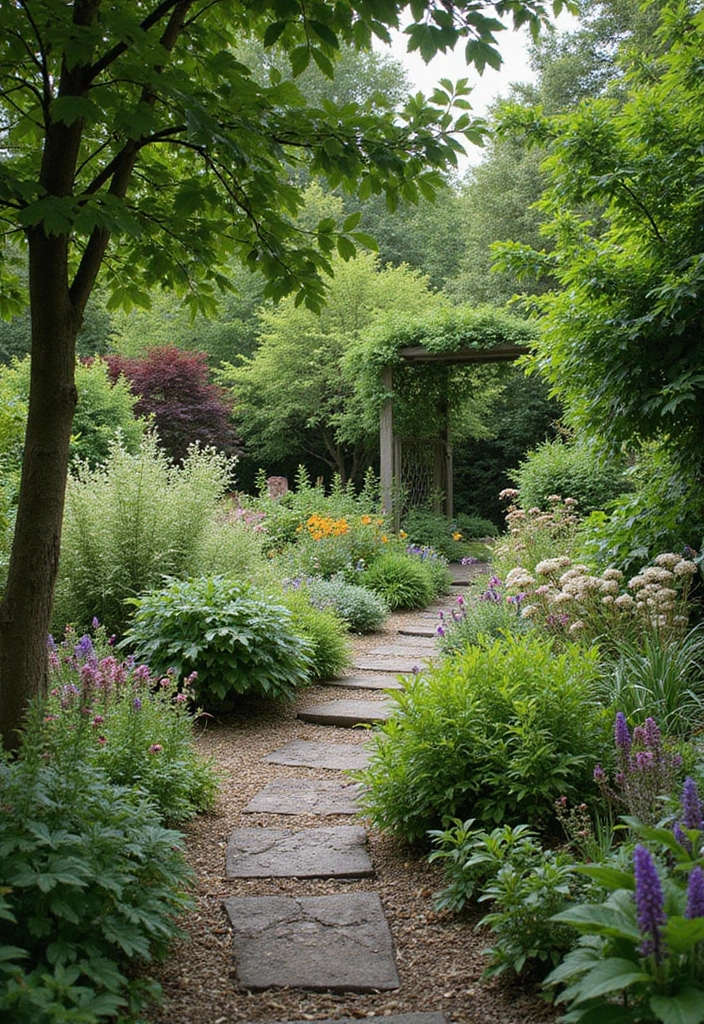
Creating an aromatic garden can enhance your outdoor experience, providing delightful scents while attracting pollinators and beneficial insects. Consider planting herbs and flowering plants that release fragrant oils.
Choose varieties like lavender, rosemary, or jasmine for a sensory experience. Incorporating these plants in seating areas or pathways ensures you can enjoy their scents while relaxing in your garden.
for aromatic gardens:
– Plan for varying bloom times to maintain scents throughout the seasons.
– Use fragrant herbs in cooking to double their utility.
– Group aromatic plants together for maximum impact.
Indulge your senses by cultivating an aromatic retreat in your garden!
24. Eco-Friendly Mulching: Protect and Enhance
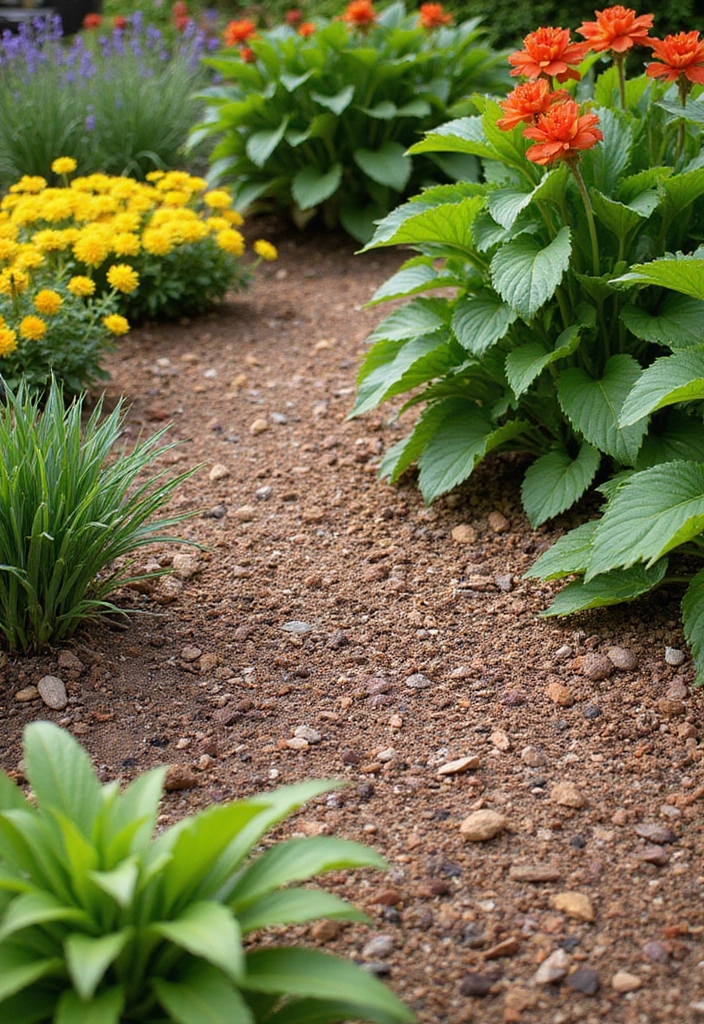
Mulching is a simple way to enhance your garden while protecting your plants. Organic mulches, like wood chips or straw, can improve soil health and suppress weeds, all while looking attractive.
Lay a layer of mulch around your plants to retain moisture, prevent soil erosion, and temperature fluctuations. As mulches decompose, they enrich the soil with nutrients.
Key benefits of mulching:
– Reduces the need for watering.
– Enhances the appearance of flower beds.
– Provides a protective barrier against pests.
Incorporating eco-friendly mulches in your garden can create a healthier, more beautiful outdoor space!
25. Artistic Borders: Define Your Space
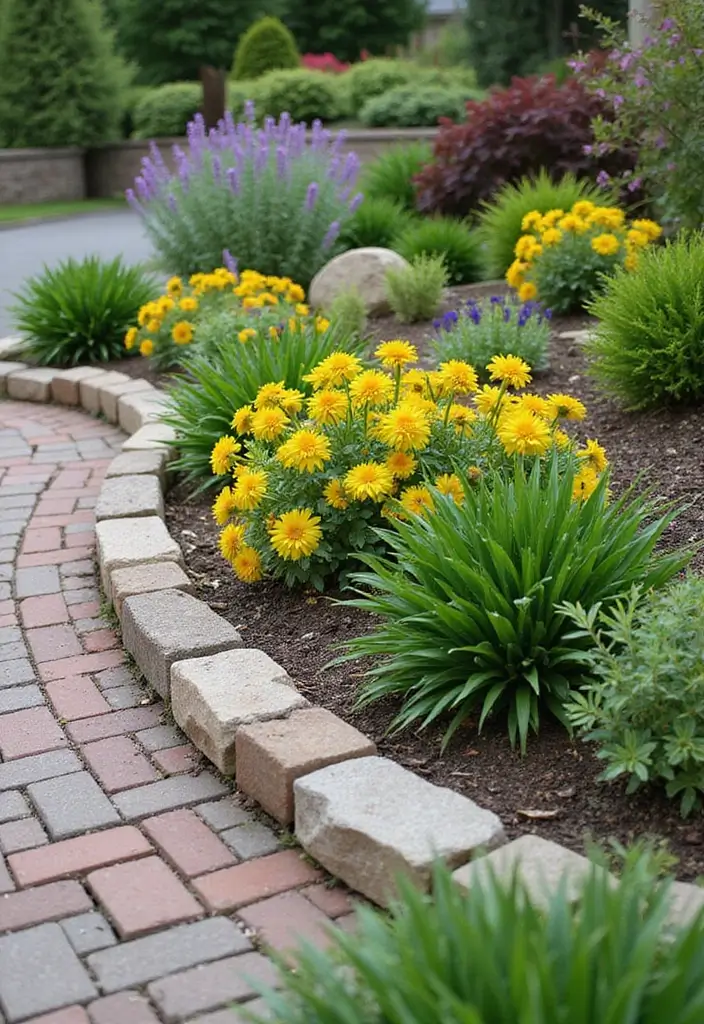
Creating artistic borders can define your garden beds and add flair to your landscaping. Use a variety of materials like stones, bricks, or wood to create unique patterns that frame your plants beautifully.
Consider using a mix of straight lines and curves for a more organic feel. These borders not only enhance visual appeal but can also help with soil retention and weed control.
for artistic borders:
– Choose materials that complement your home and garden style.
– Mix colors and textures for a dynamic look.
– Ensure borders are level for a polished finish.
Artistic borders can elevate your landscaping design and create a cohesive look for your garden!
26. Creative Lawn Games: Fun and Engagement
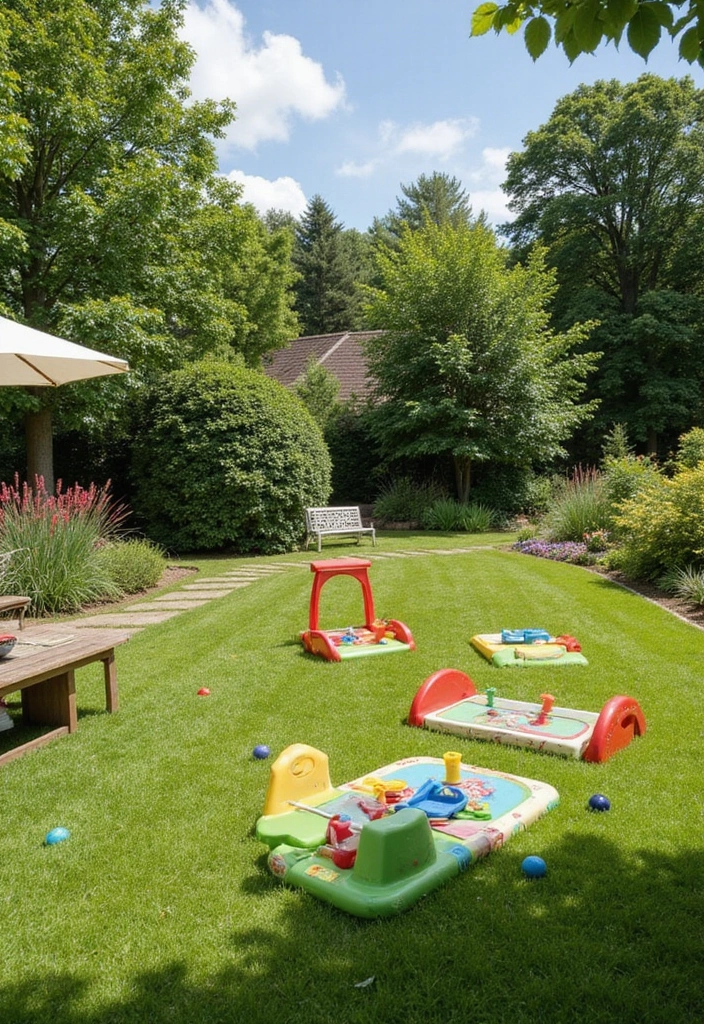
Incorporating lawn games into your outdoor living space can make your garden a fun place for gatherings. Games like cornhole or giant Jenga can appeal to friends and family while enhancing your garden’s social atmosphere.
Designate a small area in your yard for games, ensuring it is easily accessible yet still integrated into the landscape. Consider creating a cozy seating area nearby for spectators.
Ideas for garden games:
– DIY options using recycled materials for a personal touch.
– Use colorful paint for visual appeal!
– Rotate games seasonally to keep things fresh.
Lawn games can turn your garden into an entertainment hub while encouraging family interactions and outdoor activities!
27. Terraced Gardens: Maximize Your Space
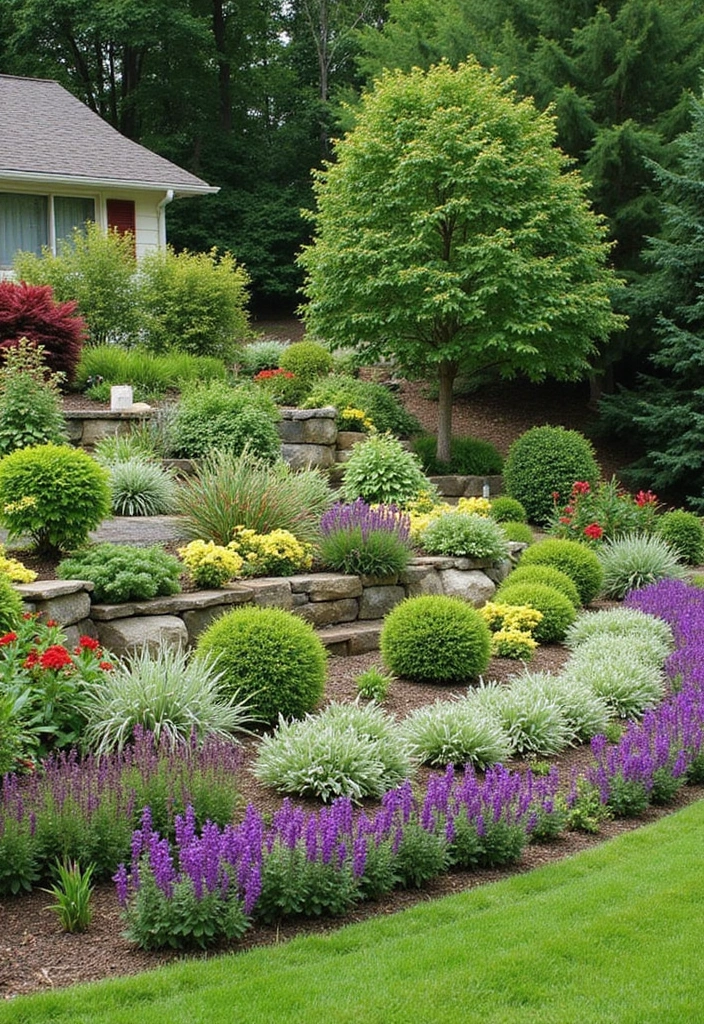
Terraced gardens can be an excellent way to make the most of steep or uneven ground while creating stunning visual interest. These multi-level gardens allow for better drainage and accessibility.
Build simple terraces using timber or stone, and fill them with a mix of flowers, herbs, and shrubs. This design can create a beautiful layered effect, optimizing every inch of your yard.
Considerations when building terraces:
– Ensure proper drainage to avoid flooding.
– Choose plants that thrive on slopes.
– Incorporate pathways for movement between levels.
With terraced gardens, even the most challenging spaces can become productive and beautiful!
28. Hillside Gardens: Embrace Natural Landscapes

If you’re blessed with a hillside, embrace its natural beauty by creating a hillside garden. These gardens can prevent erosion while offering unique planting opportunities and stunning views.
Use native plants, ground covers, and ornamental grasses to stabilize the soil while adding beauty. Incorporating pathways can help navigate the slopes while allowing for easy maintenance and enjoyment of the space.
Helpful tips:
– Choose plants suited for your climate and slope.
– Utilize mulch and rocks to reduce erosion.
– Create seating areas for breathtaking views!
Hillside gardens can be a breathtaking addition to your landscaping, showcasing the natural landscape’s charm!
29. Bee Gardens: Support Local Pollinators
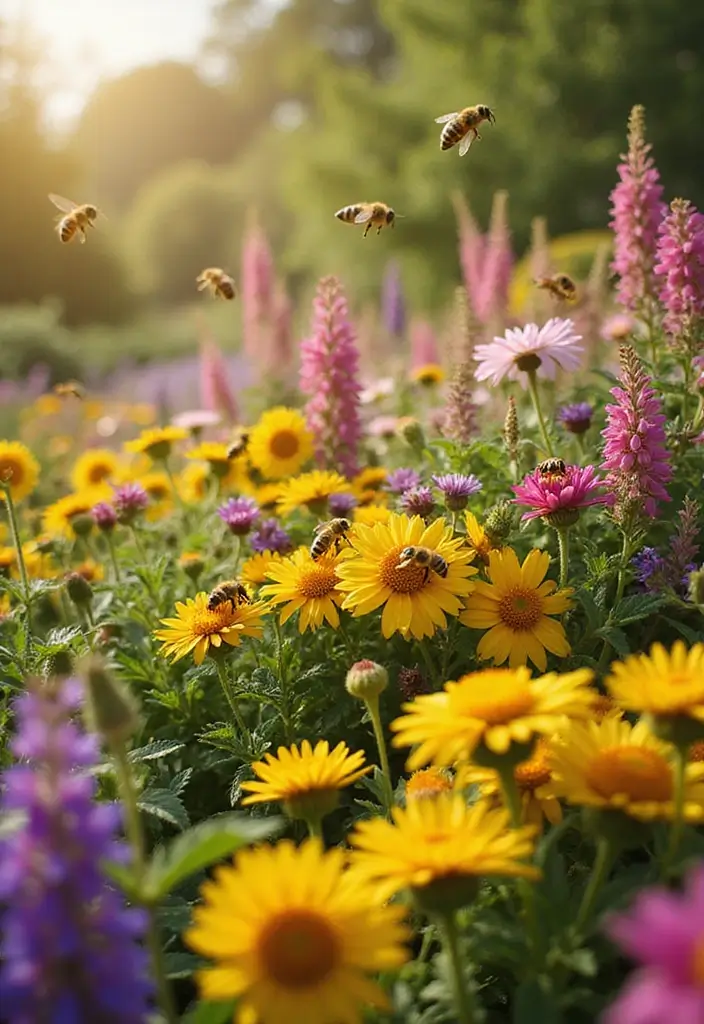
Creating a bee garden can make a significant impact on local pollinator populations. These gardens attract bees with colorful flowers and provide habitats for them to thrive.
Choose a variety of flowering plants that bloom at different times throughout the growing season to provide continuous food sources. Avoid pesticides to keep your bee friends safe!
Benefits of creating a bee garden:
– Contributes to local biodiversity.
– Supports food production by increasing pollination.
– Enhances the beauty of your garden!
By establishing a bee garden, you can enjoy the beauty of flowers while playing an essential role in supporting local ecosystems!
30. Aromatherapy Gardens: Wellness Through Nature
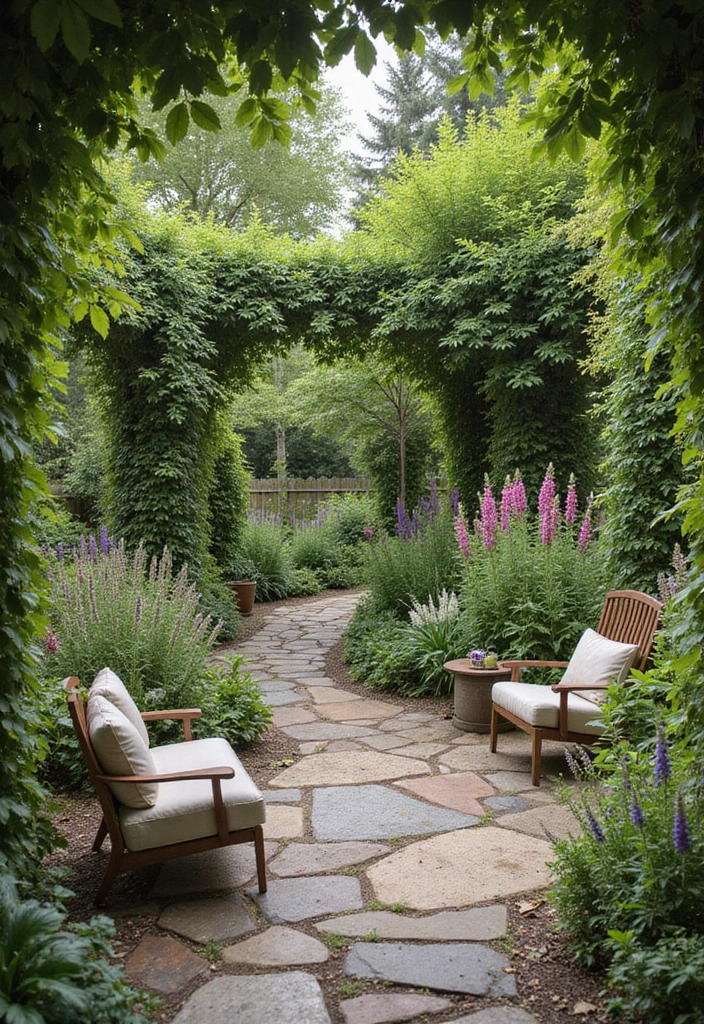
Aromatherapy gardens, rich in fragrant herbs and flowers, can provide a therapeutic escape right in your backyard. These gardens promote relaxation and mental well-being through the natural scents of plants.
Incorporate varieties like lavender, mint, and chamomile to build a calming atmosphere. Design comfortable seating areas where you can immerse yourself in the scents while enjoying quiet moments.
Considerations for your aromatherapy garden:
– Create pathways to navigate the space comfortably.
– Incorporate sensory elements, like wind chimes or water features.
– Plan for year-round beauty with evergreen herbs.
Transform your yard into a serene escape that nurtures your spirit and well-being!
Breathe in tranquility! Aromatherapy gardens filled with lavender and mint can turn your backyard into a serene sanctuary, promoting relaxation and well-being right at home.
Conclusion: Your Path to a Sustainable Garden
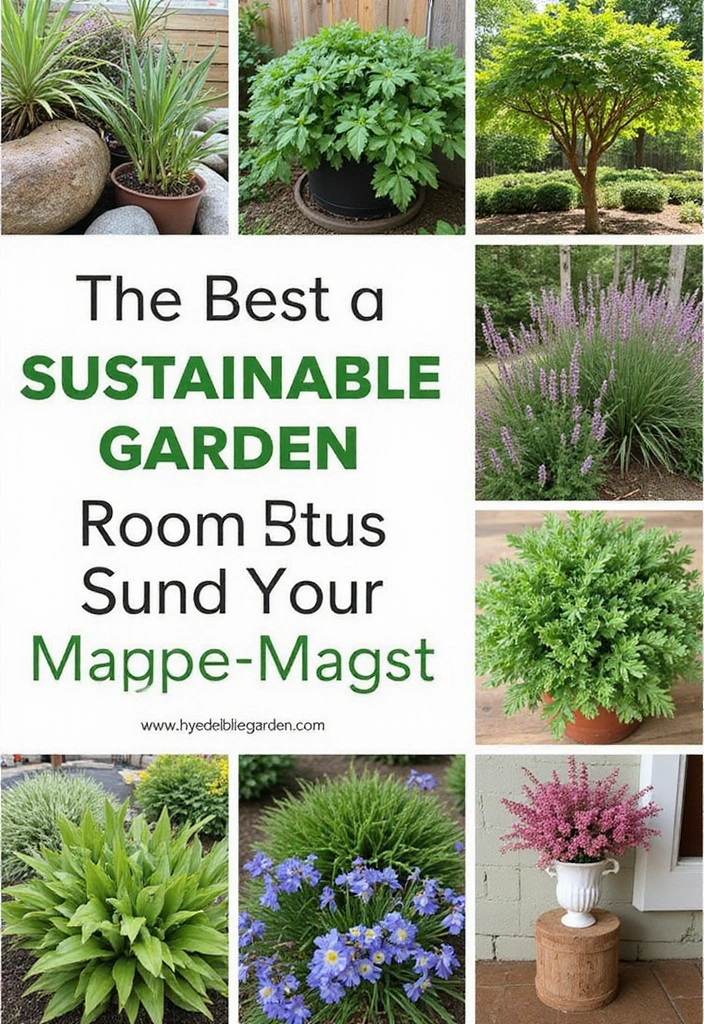
With these 30 garden landscaping ideas, transforming your yard into a sustainable and beautiful space is entirely within your reach.
From vertical gardens to natural privacy screens, each concept offers unique opportunities for creativity and ecological responsibility. Embrace these ideas to cultivate not just a garden, but a thriving ecosystem that reflects your style and values.
Happy gardening, and may your green thumb flourish!
Frequently Asked Questions
What are some sustainable garden landscaping ideas for small spaces?
Sustainable garden landscaping in small spaces can be both creative and functional! Think about incorporating vertical gardens to save ground space while adding greenery. Raised garden beds can help with drainage and accessibility. Additionally, using native plants requires less maintenance and supports local ecosystems, making them an excellent choice for sustainable gardening.
How can I create a beautiful outdoor living space on a budget?
Transforming your outdoor living space doesn’t have to be expensive! Start by upcycling decor or using containers and pots to add personality without breaking the bank. Consider making your own pathways and walkways using materials like gravel or reclaimed wood. Lastly, adding outdoor lighting can create a magical atmosphere in the evenings, enhancing your space’s appeal.
What are the latest garden design trends I should consider?
Current garden design trends emphasize sustainability and functionality. For instance, xeriscaping is gaining popularity for its water-saving benefits and beautiful drought-resistant plants. Aromatic gardens are also trending, providing both beauty and sensory delight. Don’t forget about edible landscaping—integrating food plants with ornamental ones is a fun way to merge aesthetics and practicality!
How can I attract pollinators to my garden?
Attracting pollinators is essential for a healthy garden! Create a bee garden filled with colorful flowers that bloom at different times to provide food throughout the seasons. Use native plants as they are adapted to your local environment and are more appealing to local pollinators. Additionally, consider adding water features like birdbaths to create a welcoming habitat for these beneficial insects.
What are some practical tips for maintaining a sustainable garden?
Maintaining a sustainable garden is all about smart practices! Start by composting kitchen scraps and yard waste to enrich your soil naturally. Embrace eco-friendly mulching to retain moisture and suppress weeds. Additionally, opt for sustainable lawn alternatives like clover or native ground covers, which require less water and maintenance while keeping your garden looking lush and vibrant.
